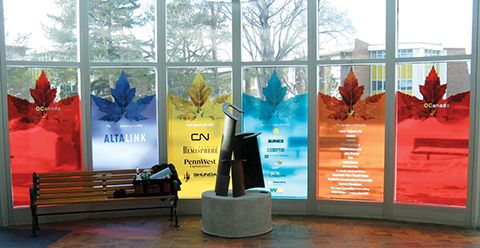Walls
A wall provides a focal point to promote a brand or customize a space, whether with short-term advertising or long-term design features. While these types of graphics have become very common today, they can be the most difficult applications to specify products for, due to the high level of variability between different walls.
Each wall will need to be tested for adhesion because different surfaces and paints have different characteristics and textures. Paints low in volatile organic compounds (VOCs), for example, have become popular for environmental, health and safety reasons, but it is inherently more difficult to adhere printed graphics to walls that have been coated with these paints.
Rough surfaces like brick and stone can only be wrapped with special, conformable films, which fortunately have become more common and faster to use. At the annual Scotiabank Contact Toronto Photography Festival, for example, wrapping an exterior wall of the Museum of Contemporary Canadian Art (MOCCA) has become faster each year.
Another issue is glare, which is influenced by a film’s gloss level. Most graffiti-resistant overlaminates are glossy, for example, while interior wall graphics typically require matte or semi-matte finishes. Given how overlaminates can change the appearance of a wall graphic, including its colours, it is important to get the client to sign off not only on the original image file, but also on its laminated appearance.

Glass has a high level of surface energy, which makes it easy to stick graphics to a window, but difficult to remove them.
Floors
The wide-format printing industry has seen a surge in floor graphics in the last two to three years. As a form of advertising, this application has certainly proven effective, with 3M’s 2014 study showing 64 per cent of people stop to read floor graphics and associated sales increase by 17 per cent.
With today’s variety of films, graphics can be applied not only to smooth floors, but also to carpets and outdoor asphalt or concrete surfaces. Again, it is important to test a film for the strength of adhesion with a given floor.
The films are also laminated with a rough texture to ensure they are safe to walk on without slipping. The adhesive must also be removable without leaving residue behind.
Redefining graphics shops
The graphics industry has transitioned to ‘just in time’ printing and one-to-one marketing, with advertisers ordering new graphics more frequently for more customized campaigns. The number of digitally printed applications has also exploded, putting pressure on providers who feel they need to be able to wrap everything.
In response, many sign shops, screenprinting companies and other traditional businesses are redefining themselves as print service providers (PSPs) or ‘digital service bureaus,’ focusing on value-added visual communications consulting, rather than just printing. As they move from mass production to customization, they are supported by automated technology, which has greatly reduced the amount of labour needed to create each graphic application.
To produce outdoor-durable graphics, a shop needs a piezoelectric inkjet printer, which may use solvent-based, eco-solvent, ultraviolet-curable (UV-curable) or durable aqueous ‘latex’ inks. All of these printers and inks offer their own strengths and limitations. Customers do not care which technology is used, of course, so long as they can buy good quality, on time, at a reasonable price.
A shop also needs a digital front end, pre-press software, a laminator, a cutter and an inventory of media, not to mention well-trained staff, salespeople and graphic installers. Professional-quality installation is especially important because, with a lower barrier to entry, anyone can get into the business today and start printing graphics, so there is a lot of competition.





